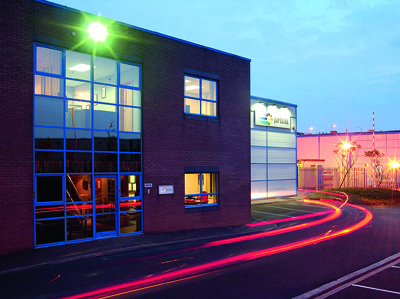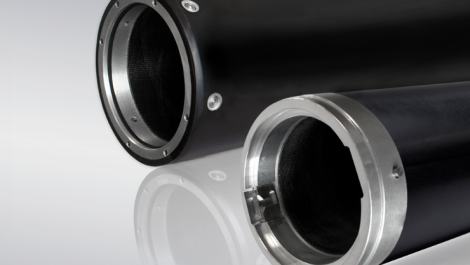Parkside Flexibles’ site near Wakefield, West Yorkshire
As changing economic circumstances force companies throughout the UK to review their strategies, Parkside Flexibles, based near Wakefield, West Yorkshire, has used its experience to position itself as a converter that specialises in technically difficult packaging. Michal Lodej went to visit.
As you arrive at the Parkside Flexibles site, it looks no different to most other flexo printers in the UK, a large industrial building, with little to give away what goes on inside. After entry however, the industrial façade gives way to a clean, modern and vibrant office space.
The aim here is to create a point of difference. Nick Smith, managing director, said, ‘When people come to visit us we want them to get a sense that we are different to other printers in the industry. The work we do is different and the environment here reinforces that.’
Mr Smith has been managing director of the company since March 2014 and in this time he has steered the company safely through some major strategy changes. Parkside Flexibles was previously involved with tobacco packaging printing, and had a strong connection with major tobacco suppliers Imperial Tobacco (Davidoff, West, JPS, Gauloises Blondes and Golden Virginia) for forty years, and JTI (Benson & Hedges, and Silk Cut) for over 30 years, respectively.
Finding new markets
However, in response to the UK government implementing a plain packaging policy for cigarettes these companies withdrew their business, resulting in the need for Parkside to redefine its business strategy.
Mr Smith explained, ‘We understood that we didn’t have the scale to completely change tack and replicate the models of our competitors, while matching them on price. So, we knew that we must drive our strategy forward based on what we do well.
‘Thanks to our experience in the tobacco industry, we could deliver technically demanding jobs extremely effectively. But as we weren’t well known outside of the tobacco industry, the challenge was how to get ahead of our major competitors, who already had an established customer base.
‘Building trust with a new customer base was essential to the success of our evolving strategy by promoting our innovative, customer-led products. By doing this, we could create differentiation through our technical product development expertise.
‘Of course, it was always going to be challenging to deliver a good margin, initially. The UK packaging industry has been driven down so much on price there is very little room to manoeuvre. At Parkside, we thrive on a challenge so this acted as a driver for change.’
Getting technical
One example of the technically demanding work Parkside has executed for cigarette packaging is a triplex laminate film in colour, a very complex job made more complex by a manufacturing speed of 600 packs per minute which leaves no room for error.
An application outside of tobacco, which is a leading example of the type of application the company aimed to switch to, was designed for Lofthouse of Fleetwood, the company behind the brand Fisherman’s Friends.
The new Fisherman’s Friends pack, designed for the Asian market, takes the traditional structure of tobacco packaging and equips it with a zip lock. In areas with high humidity these high barrier packs are ideal for protecting the products from the moisture in the air. Production of the pack was made possible with the use of a laser the company purchased in 2013. The laser opening gives easy access to the consumer in the high barrier material.
The pack’s success was a green light to the company to drive forward its new business strategy. The future of innovative and highly technical packaging, supplemented with more standard flexo jobs, was secured at Parkside.
Mr Smith continued, ‘To do this properly we had to invest. We developed the site, creating an enhanced environment for our customers. We created two new departments, one focussing on innovating and the other on testing to experiment with new packaging ideas.’

Brands with an ethical image such as SIPP want packaging that reflects its ethos and values, such as biodegradable packaging
Problem solving
The company first began looking at solving technical issues with common types of packaging and then selling these solutions on to customers.
Realising that its solutions had to get to the heart of the issues its customers were looking to address, Parkside started to explore the consumer journey rather than the packaging journey to understand what the consumer really wanted from its packaging.
Phil O’Driscoll, Parkside’s innovation director, comes from an FMCG background and so has the experience to help guide the company in this route. He added, ‘Our best strategy is to know what our customer’s customer wants.’
Parkside product development is now market led, rather than technically pushed, but even when customers say they want something different or innovative, they do not necessarily budget for it.
What the company works hard to do work in collaboration with its customers to create relevant added value in their packaging. Mr Smith continued, ‘As well as technical excellence, it’s about making our packaging fit for purpose and adding additional value wherever we can. The consumer is key to informing us on the functional and added value features that really matter to them. Ultimately the consumer wants easy to open packaging that doesn’t require the use of a knife or scissors. And if that packaging is easily sealed, without the use of additional materials such as cling film, then we’ve added value that matters to the everyday consumer.’
New openings
Reclosable packaging has huge market potential and is one product which has been produced by the company since the installation of the laser. Working with crisp manufacturer Seabrook, the company designed a packaging solution that is perfectly suited to sharing (or for one person to consume over a number of days) with a recloseable feature.
Mr Smith explained, ‘The idea behind this pack was that it’s at the forefront of the consumer experience.’
The new packaging design was a great success and gave Seabrook a significant growth in market share.
‘There is a lot of technical knowhow needed to do something like this with a laser, it’s not a case of just going out, buying one and starting to laser things. It’s simply not that straight forward. But getting it right puts products into new markets which were impossible to break into before,’ said Mr Smith.
New markets are exactly what the company aims for, by pioneering a packaging product in a way no one else has they can take a lead in that market. Mr Smith explained, ‘We still look at the technical know-how, but it’s a blend of customer understanding and manufacturing experience and taking these into the end design. When we looked at the consumer experience and how the package is used, we can see where it works and where it fails.’

Seabrook’s crisp packaging can be resealed to help with portion control and its design makes it easier for sharing
No plastics no problem
There is one area in particular where the company has seen a huge rise in demand, and that is in compostable materials.
Mr Smith explained, ‘We started looking at compostable materials about seven years ago. Following customer requests to find a sustainable alternative to the plastic pack, we explored this possibility and developed a number of structures which could be compostable.’
The company has accredited 19 structures as compostable, the majority of those are compatible with home composting (within 26 weeks), with the rest considered viable for industrial composting (under 12 weeks).
‘Simply using “compostable” materials is not the full story. While some materials are compostable, when combined in a structure with different adhesives, the material may not decompose in the same way,’ explained Mr Smith.
Parkside has worked closely with its substrate providers and adhesive supplier to ensure its compostable packaging does.
Enabling change
Early uptake was mainly start ups or artisan brands that opted for the different options in Parkside’s compostable range. These brands want to follow through with their ethical image and this means getting the right packaging.
‘The challenge is that compostable packaging is more expensive. Pre Blue Planet II we were working with about six or seven companies, but now interest has rocketed. Our seven year head start with development now puts us in a market leading position. There has been real pull from Australia for compostable materials, and we have now achieved accreditation from ABA in Australia.
‘We have scientific confirmation that one particular packaging structure of ours biodegrades in sea water. Obviously, in an ideal world no litter at all would enter the oceans, but with this we know even if that does happen, within six months this material will be gone. This kind of development doesn’t happen overnight, it is a long journey and it has taken six months
of testing.
‘Brands typically have more than one product, and look for standout features depending on that particular product. When we talk about core areas like recyclable packaging it needs to be complementary. This range is not a replacement to plastic but an alternative – we can now offer brands a choice.’
With public pressure building, one would think that many brand owners will take the opportunity to use compostable packaging in their own effort to help battle pollution. If they do not, the alternative could be worse in years to come.
Speaking about the need for industry wide change Mr Smith said, ‘It needs to be a series of changes over a period of time that results in the right solution, not just the knee-jerk reaction that we have seen recently. The industry needs to grow and adapt.’
From its experience with tobacco production, Parkside knows all too well what happens when governments step in to change an industry before it does so itself, but if that was to happen in packaging, at least this time, they will be ready.






